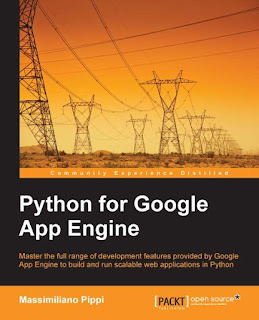Python For Google App Engine: Master the full range of development features provided
by Google App Engine to build and run scalable web
applications in Python
Download
Introduction
What this book covers
Chapter 1, Getting Started, will help you get your hands dirty with a very simple
functional Python application running on a production server. The chapter begins
with making a survey of Google's cloud infrastructure, showing where App Engine is
placed and how it compares to other well-known cloud services. It then walks readers
through downloading and installing the runtime for Linux, Windows, and OS X,
coding a Hello, World! application and deploying it on App Engine. The last part
introduces administration consoles both for the development and production servers.
Chapter 2, A More Complex Application, teaches you how to implement a complex web
application running on App Engine. It begins with an introduction to the bundled
webapp2 framework and possible alternatives; then, you will get in touch with user
authentication and form handling and then an introduction to Google's Datastore
nonrelational database. The last part shows you how to make HTML pages through
templates rendering and how to serve all the static files needed to style the page.
Chapter 3, Storing and Processing Users' Data, will show you how to add more
functionalities to the app from the previous chapter. The chapter begins by showing
you how to let users upload files using Google Cloud Storage and how to manipulate
such files when they contain image data with the Image API. It then introduces you
to the task queues used to execute long jobs (such as image manipulation) outside
the request process and how to schedule batches of such jobs. The last part shows
you how to send and receive e-mails through the Mail API.
Chapter 4, Improving Application Performance, begins by showing how to improve
application performance using advanced features of Datastore. It then shows you
how to use the cache provided by App Engine and how to break the application into
smaller services using Modules.
Chapter 5, Storing Data in Google Cloud SQL, is dedicated to the Google Cloud
SQL service. It shows you how to create and manage a database instance and
how to connect and perform queries. It then demonstrates how an App Engine
application can save and retrieve data and how to use a local MySQL installation
during development.
Chapter 6, Using Channels to Implement a Real-time Application, shows you how to make
our application real time, in other words, how to update what clients see without
reloading the page in the browser. The first part shows how the Channel API works,
what happens when a client connects, and what roundtrip of a message is from
the server to the client. Then, it shows you how to add a real-time feature to our
application from previous chapters.
Chapter 7, Building an Application with Django, teaches you how to build an App
Engine application using the Django web framework instead of webapp2. The
first part shows you how to configure the local environment for development, and
then the application from previous chapters is rewritten using some of the features
provided by Django. The last part shows you how to deploy the application on a
production server.
Chapter 8, Exposing a REST API with Google Cloud Endpoints, shows you how to
rewrite part of our application to expose data through a REST API. The first part
explores all the operations needed to set up and configure a project and how to
implement a couple of endpoints for our API. The last part shows explores how to
add OAuth protection to the API endpoints.
What you need for this book
In order to run the code demonstrated in this book, you need a Python interpreter
for version 2.7.x and the App Engine Python SDK as described in the Download and
installation section from Chapter 1, Getting Started.
Additionally, to access the example application once it runs on App Engine, you
need a recent version of a web browser such as Google Chrome, Mozilla Firefox,
Apple Safari, or Microsoft Internet Explorer.
Who this book is for
If you are a Python programmer who wants to apply your skills to write web
applications using Google App Engine and Google Cloud Platform tools and
services, this is the book for you. Solid Python programming knowledge is required
as well as a basic understanding of the anatomy of a web application. Prior
knowledge of Google App Engine is not assumed, nor is any experience with a
similar tool required.
By reading this book, you will become familiar with the functionalities provided
by Google Cloud Platform with particular reference to Google App Engine, Google
Cloud Storage, Google Cloud SQL, and Google Cloud Endpoints at the latest
versions available at the time of writing this book.
Home Web Development Python For Google App Engine

